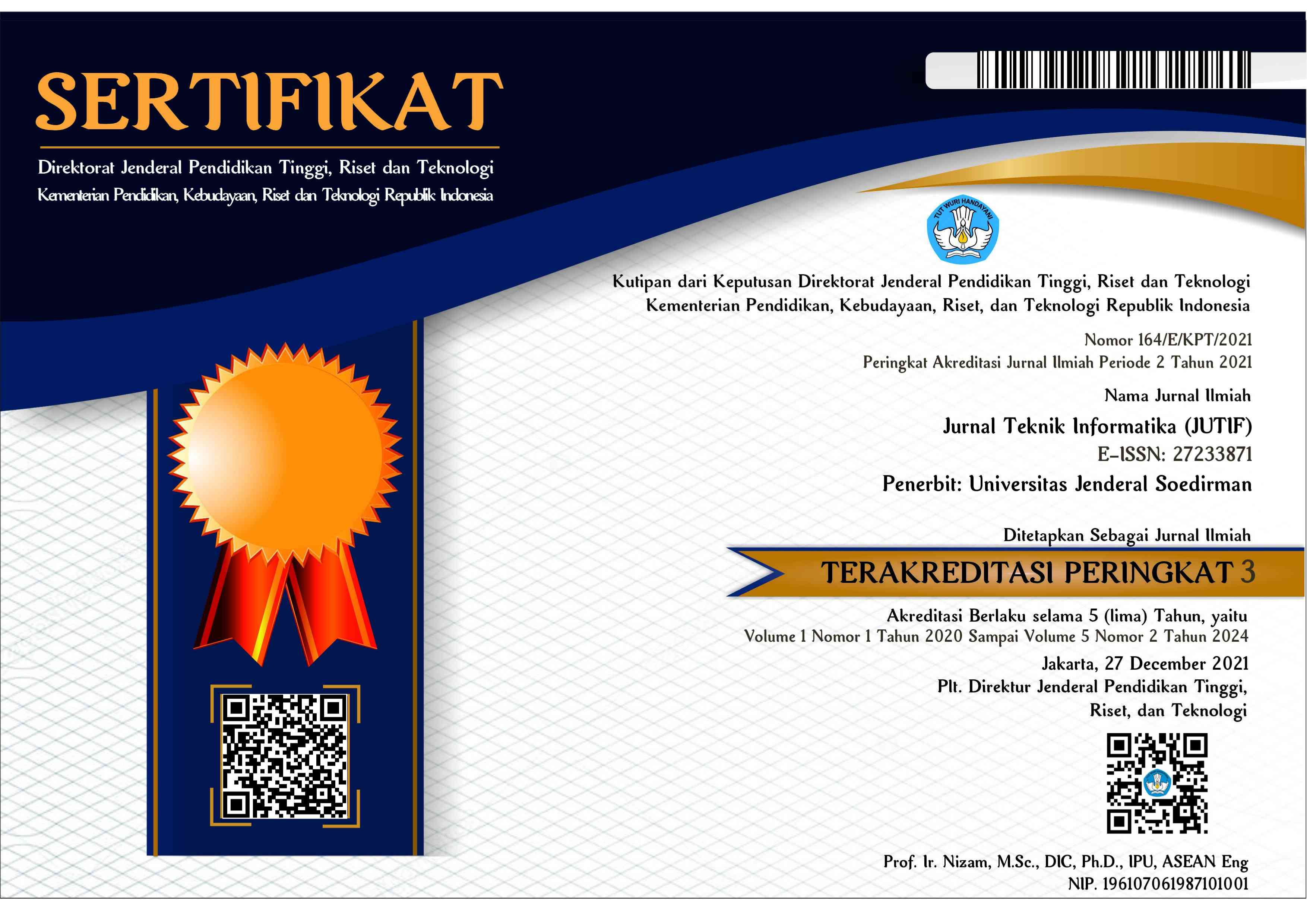OPTIMIZATION OF THE K-NEAREST NEIGHBORS ALGORITHM USING THE ELBOW METHOD ON STROKE PREDICTION
Abstract
Stroke is the second most deadly disease in the world according to WHO. The sufferer has an injury to the nervous system. Because of this, health experts, especially in the field of nursing, need special attention. Technological advances continue to change over time so that information needs are needed in life. Currently the data on stroke sufferers is extensive enough so that adequate information presentation techniques are needed so that the information received is very accurate and in accordance with user needs. Therefore, it is necessary to process data mining on stroke patient data to obtain useful information for users. This study aims to prove the performance of the Elbow Method to produce the optimum k value in the stroke prediction data using the K-Nearest Neighbors (KNN) algorithm. The optimum k value is generated from the Elbow Method which is executed with the Google Collaboratory using the Python programming language. The test results show that the Elbow Method produces the optimum k value at k = 7. The KNN model that uses the optimum k value from the Elbow Method can increase the accuracy and precision values reaching 6% and 0.12, respectively.
Downloads
References
A. Byna and M. Basit, “Penerapan Metode Adaboost Untuk Mengoptimasi Prediksi Penyakit Stroke Dengan Algoritma Naïve Bayes,” Jurnal Sisfokom (Sistem Informasi dan Komputer), vol. 9, no. 3, pp. 407–411, 2020, doi: 10.32736/sisfokom.v9i3.1023.
J. Kissane, J. A. Neutze, and H. Singh, Radiology fundamentals: Introduction to imaging & technology. Springer Nature, 2020.
J. S. Brown, “Ending the doctor-nurse game by enhancing the role of the ward nurse,” BMJ, p. l698, Feb. 2019, doi: 10.1136/bmj.l698.
A. Faisal and A. Subekti, “Deep Neural Network untuk Prediksi Stroke,” Jurnal Edukasi dan Penelitian Informatika (JEPIN), vol. 7, no. 3, p. 443, 2021, doi: 10.26418/jp.v7i3.50094.
J. Heo, J. G. Yoon, H. Park, Y. D. Kim, H. S. Nam, and J. H. Heo, “Machine Learning–Based Model for Prediction of Outcomes in Acute Stroke,” Stroke, vol. 50, no. 5, pp. 1263–1265, May 2019, doi: 10.1161/STROKEAHA.118.024293.
V. Adelina, “Klasifikasi Tingkat Risiko Penyakit Stroke Menggunakan Metode GA-Fuzzy Tsukamoto,” Universitas Brawijaya, 2018.
I. Cholissodin, F. Farisuddin, and E. Santoso, “Klasifikasi Tingkat Resiko Stroke Menggunakan Improved Particle Swarm Optimization dan Support Vector Machine,” Konferensi Nasional Sistem & Informasi, pp. 11–13, 2016.
K. Shameer, K. W. Johnson, B. S. Glicksberg, J. T. Dudley, and P. P. Sengupta, “Machine learning in cardiovascular medicine: are we there yet?,” Heart, vol. 104, no. 14, pp. 1156–1164, Jul. 2018, doi: 10.1136/heartjnl-2017-311198.
M. S. Singh and P. Choudhary, “Stroke prediction using artificial intelligence,” in 2017 8th Annual Industrial Automation and Electromechanical Engineering Conference (IEMECON), Aug. 2017, pp. 158–161. doi: 10.1109/IEMECON.2017.8079581.
F. Dhewayani, D. Amelia, D. Alifah, B. Sari, and M. Jajuli, “Implementasi K-Means Clustering untuk Pengelompokkan Daerah Rawan Bencana Kebakaran Menggunakan Model CRISP-DM,” Jurnal Teknologi dan Informasi, vol. 12, no. 1, pp. 64–77, 2022, doi: 10.34010/jati.v12i1.6674.
A. Winarta and W. J. Kurniawan, “Optimasi cluster k-means menggunakan metode elbow pada data pengguna narkoba dengan pemrograman python,” Jurnal Teknik Informatika Kaputama (JTIK), vol. 5, no. 1, pp. 113–119, 2021.
N. T. Hartanti, “Metode Elbow dan K-Means Guna Mengukur Kesiapan Siswa SMK Dalam Ujian Nasional,” Jurnal Nasional Teknologi dan Sistem Informasi, vol. 6, no. 2, pp. 82–89, 2020, doi: 10.25077/teknosi.v6i2.2020.82-89.
H. Said et al., “Penerapan Algoritma K-Nearest Neighbor Untuk Memprediksi Kualitas Air Yang Dapat Dikonsumsi,” vol. 21, no. 2, pp. 256–267, 2022.
D. A. I. C. Dewi and D. A. K. Pramita, “Analisis Perbandingan Metode Elbow dan Silhouette pada Algoritma Clustering K-Medoids dalam Pengelompokan Produksi Kerajinan Bali,” Matrix : Jurnal Manajemen Teknologi dan Informatika, vol. 9, no. 3, pp. 102–109, Nov. 2019, doi: 10.31940/matrix.v9i3.1662.
Fedesoriano, “Stroke Prediction Dataset | Kaggle.” https://www.kaggle.com/datasets/fedesoriano/stroke-prediction-dataset/code?datasetId=1120859 (accessed Jun. 10, 2022).
R. R. Rerung, “Penerapan Data Mining dengan Memanfaatkan Metode Association Rule untuk Promosi Produk,” Jurnal Teknologi Rekayasa, vol. 3, no. 1, p. 89, 2018, doi: 10.31544/jtera.v3.i1.2018.89-98.10.26634/jse.13.3.15515..
Copyright (c) 2023 Febri Sutomo, Daffa Ammar Muaafii, Daffa Naufaldi Al Rasyid; Yogiek Indra Kurniawan; Lasmedi Afuan, Teguh Cahyono, Eddy Maryanto, Dadang Iskandar

This work is licensed under a Creative Commons Attribution 4.0 International License.




























